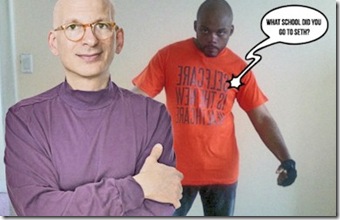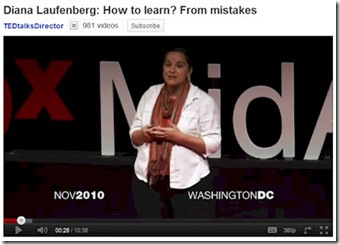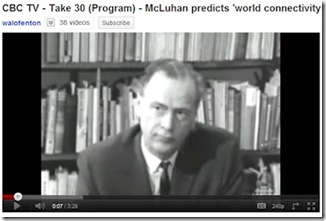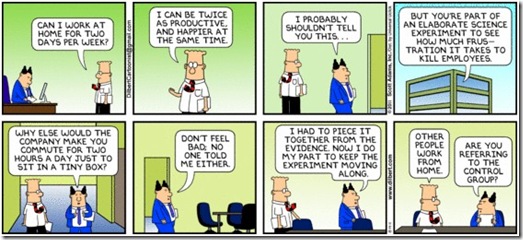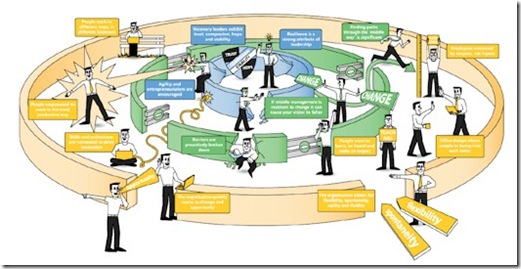Dilbert steps up the incisive wit on the techno-laggards whose outdated approaches are the #1 impediment to the growth of Dynamic Work. Seemed appropriate today having just gotten off a video call with family across the Atlantic for an extended video chat, including a couple of video ‘tours’ of new things to show off, sharing our Christmas Day together. Oh, and the total cost of this space age technology…zero. Ho, ho, ho.
Author: DWAdmin
Education Factories
Yes, it is back to school season. But Seth Godin’s incisive plea for such restructuring of education suggests that it may be ‘Back to (the wrong) school’ season.
Education factories fill Office Worker factories. Part of many Dynamic Work transformations includes a range of re-skilling and education around new tools, new ways of working, new ways of communicating. But as the world moves inexorably to Dynamic Working (and those not so moving get left behind at their peril), we can start the readiness much earlier. Back in school, for example.
“Part of the rationale to sell this major transformation to industrialists was that educated kids would actually become more compliant and productive workers. Our current system of teaching kids to sit in straight rows and obey instructions isn't a coincidence–it was an investment in our economic future. The plan: trade short-term child labor wages for longer-term productivity by giving kids a head start in doing what they're told… Do you see the disconnect here? Every year, we churn out millions of of worker who are trained to do 1925 labor… As long as we embrace (or even accept) standardized testing, fear of science, little attempt at teaching leadership and most of all, the bureaucratic imperative to turn education into a factory itself, we’re in big trouble.”
Dynamic Classroom
Dynamic Work can start in the Dynamic Classroom.
This is ‘Back to School’ season and I have done a few pieces in one of my other blogs (‘Leadership and Management / Turning Adversity to Advantage’) on the timely subject. Both pieces feature endorsements of ‘dynamic work’ applied to the classroom.
Diane Laufenberg’s TED talk explored new modes of flexible learning and complemented, as with Dynamic Work, with the latest technology like laptops which could go between home and class…
“I moved there primarily to be part of a learning environment that validated the way that I knew that kids learned, and that really wanted to investigate what was possible when you are willing to let go of some of the paradigms of the past, of information scarcity when my grandmother was in school and when my father was in school and even when I was in school, and to a moment when we have information surplus. So what do you do when the information is all around you? Why do you have kids come to school if they no longer have to come there to get the information?”
FailureMag’s piece on ‘Geeks’ proposed unconventional furnishing to areas like the cafeteria to promote intermingling and the breakdown of destructive cliques (‘Dynamic Lunch’!)…
“One of the easiest things a school can do is to change the cafeteria seating so that there are a varying number of chairs at each table to accommodate groups of different sizes. And schools can set out a handful of loose chairs so that floaters—kids who don’t belong to any single group—can go from table to table and don’t have to feel they have to choose one group and stay there.”
The Filing Cabinet
While Dynamic Work is growing in mainstream acceptance daily, it is still seen as rather forward thinking by most. Actually, the thinking has been around for decades. Admittedly by one of the most prescient social commentators ever – Marshall McLuhan. One of those seers insanely ahead of his time like Gaudi, da Vinci and Lloyd Wright. In this television interview (thanks Eileen), he describes the heart of Dynamic Work with chilling foresight. He envisions the ‘Internet’ long before its invention described as a variation of ‘closed circuit TV’ (not far off there).
Here he describes the insanity of the current structure of the workplace and how new approaches will change all of this including more distributed working environments…
“In our own world, we are hurrying back and forth across town morning and night to situations which we could quite easily encompass by close circuit. Why do the wheels keep hurrying us downtown? As some people are puzzled by this and have come up with the answer, it’s the filing cabinet. Downtown and the offices that makes it still necessary to rush back and forth from suburb to the office. That it is this obsession with the contents of the file…documents, contracts, data. All of these materials could be available, actually, on closed circuit at home. The stockbroker long ago discovered this. That the telephone enables him to conduct his business anywhere.”
Elaborate Science Experiment
Synchronicity, Intimacy and Productivity
Seth Godin has been a real inspiration to me in marketing (‘Purple Cow’ which inspired the ‘Best Of Maldives’ section to my Maldives Complete blog) as well as in Leadership and Management / Embracing Failure.
Godin even offers some sage insights into workstyles and the balance between when face-to-face is important and when getting people out of your face is important. Unfortunately, traditional work environments with their one-size-fits-all don’t readily cater to this dichotomy.
“A shortcut to customer and co-worker intimacy is to respond in real time. A phone call is more human than an email, a personal meeting has more impact than a letter. On the other hand, when you do your work on someone else's schedule, your productivity plummets, because you are responding to the urgent, not the important, and your rhythm is shot. The shortcut analysis, it seems to me, is to sort by how important it is that your interactions be intimate. If it's not vitally important that you increase the energy and realism of the relationship, then insert a buffer. Build blocks of time to do serious work, work that's not interrupted by people who need to hear from you in real time, right now. On the other hand, for interactions when only a hug or a smile will do, allocate the time and the schedule to be present. Confusing the two is getting easier than ever, and it's killing your ability to do great work.”
I’m doing research for Maldives Complete right now (my dynamic work space has taken me to underneath a palm tree in the Indian Ocean) and I often get asked ‘What is the best Maldive resort?’ (there are over 100 of them). My answer is ‘There is no best resort, there is only the best resort for you.’ The same response applies to dynamic working. I often get asked, ‘What is the best work environment?’ There is now best environment, only the best environment for the combination of you and your work to be done.
Hybrid Organisation
The bigger they are, the harder they toil.
That’s the finding of a recent study into workplace practices by Microsoft UK’s ‘Hybrid Organisation’ initiative.
“The study revealed that even though the majority of office workers want to work more flexibly, the larger the organisation, the less likely its employees are enabled to do so. Half of the people participating in the study said they lacked access to the most basic technology tools that would enable them to work away from the office.”
I found in my year working on Dynamic Work Ltd that the sweet-spot was organisations around 1,000 staff. Upper middle market. As the Vanson Bourne study highlights, the smaller companies do a pretty good job themselves of incorporating new and flexible ways of working. On the other hand, I found that large enterprises (ie. thousands of staff) simply had too much bureaucracy, legacy, complexity and inertia to get substantive innovations in the workplace moving.
Ironically, at the same time that Microsoft announced the advantages to changing business practices, especially when enabled by IT, it also announced that it was retiring the ‘Business Value Productivity’ service. When I left Microsoft to start ‘Dynamic Work Limited’, my biggest impetus was the opportunity that these BVPS services (provided by partners such as I was setting Dynamic Work Ltd to be) presented. Not only did I feel strongly about the ‘New World of Work’ principles, but I felt that the Business Value coupons would really motivate and help companies to make bold steps in these directions. Conversely, one of the big reasons I chose to discontinue with Dynamic Work Limited commercially (though I continue to do writing and activism like I am doing right here and now), was the eventual realisation that Microsoft was neither supporting the New World of Work initiative nor the Business Value services. These initiatives were brochureware to adorn their websites and and keynotes.
The report has some valid research that provides helpful data points for people trying to make a business case for more dynamic working. Some fine case studies of the likes of Macquarie Bank, Nuffield Health and GlaxoSmithKline. It also features some useful models such as the ‘Follow Me Organisation’ and the ‘Bump Organisation’. Unfortunately, given Microsoft’s erratic track record in this area, the piece itself smacks of being little more than a PR exercise for Microsoft rather than heartfelt or inspired innovation.
Crying Babies
Last week’s Dilbert cartoon highlights a common misconception about Dynamic Work. The notion that changes mean a loss of something when in reality, when done properly, it introduces the addition of something.
This cartoon pokes fun at losing privacy and quiet space, when in actuality a Dynamic Work environment has lots of extra quiet spaces for people to work in. Those quiet spaces might be someone’s home. They might be a quiet remote spot in the countryside. They might be a specially designed work room.
You get the same reaction about introducing home or remote working. People fear that they will lose the camaraderie and serendipity of the office. But, again, Dynamic Work, means adding remote working space to centralised hub working space. There might be less space overall because the choice introduces a big efficiency. But people still have the best of both worlds – a place to hook up and meet face to face, and the options to ‘get away’.
The strip does highlight that there are no silver bullet solutions to workplace design. Only a holistic approach can get the right balance of resources and practices.
Burning Pine
Yesterday, I met with fellow Microsoft alum Andrew Munro with whom I had endured extensive trench warfare on the frontlines at Microsoft. He has set up a consultancy, Burning Pine, which helps organisations to “navigate the future; exploring the unmapped” which parallels much of the mission and vision of Dynamic Work. I especially applaud his white paper ‘All Gone Home’ which highlights a number of central Dynamic Work themes.
“The prospect of creating a firm which is unfettered by the boundaries of geography, time or organisation is now a practical reality. Imagine people working together but in different parts of the world; covering different time-zones and also different working patterns (your best work is done as the sun rises, mine gets done somewhere around midnight); employees, partner firms and freelance professionals sharing information securely across time and space. Why bother with a physical office at all?”
From my ‘Leadership and Management’ perspective, I also enjoy his ‘Burning Pine’ name and logo which represents the ‘burning’ flash of upside (literally from the sky) of Leadership coupled with the (again, literally) grounded wisdom (limiting downside) of Management. Sweet metaphor.
Where We Are Available: Facebook Killer
The whole notion of ‘where you are available’, which I vetted a few years ago, is not only becoming more accepted, but is actually becoming a bit of an explosion. The biggest incarnation is the whole Foursquare trend.
Dilbert’s Scott Adams also chimed in on the concept with his own post titled ‘Facebook Killer’.
“Here's the Facebook killer part of my post. As I mentioned, Facebook is primarily a record of your past. Imagine a competing service that I will name Futureme for convenience. It's an online system in which you post only your plans, both immediate and future…The interface for Futureme is essentially a calendar, much like Outlook. But it would include extra layers for hopes and goals that don't have specific dates attached. For every entry to your Futureme calendar, you specify who can see it, including advertisers. If you allow advertisers a glimpse of a specific plan, it would be strictly anonymous. Advertisers could then feed you ads specific to your plan, while not knowing who they sent it to…The biggest benefit of the system could come from your network of friends and business associates. Suppose you post on the system that you would like to see a Bon Jovi concert sometime in the next year. Now your friends – the ones you specify to see this specific plan – can decide if they want in on it. Maybe someone you know can get free tickets, and someone has a van and is willing to be the designated driver. Maybe someone has a contact that can get you backstage passes. By broadcasting your plan, you make it possible for others to improve your plan.”
Adams extends the concept from sharing ‘where’ you’ll be ‘available’ to ‘what’ you will be ‘doing’. That way the people who might want to intersect and augment what you are ‘doing’ can contribute not just by joining you, but perhaps with some other service or support. Adams even sees the direct link with the concept at the Outlook tool as I highlighted. Maybe someday Microsoft will innovate in this area after all.

